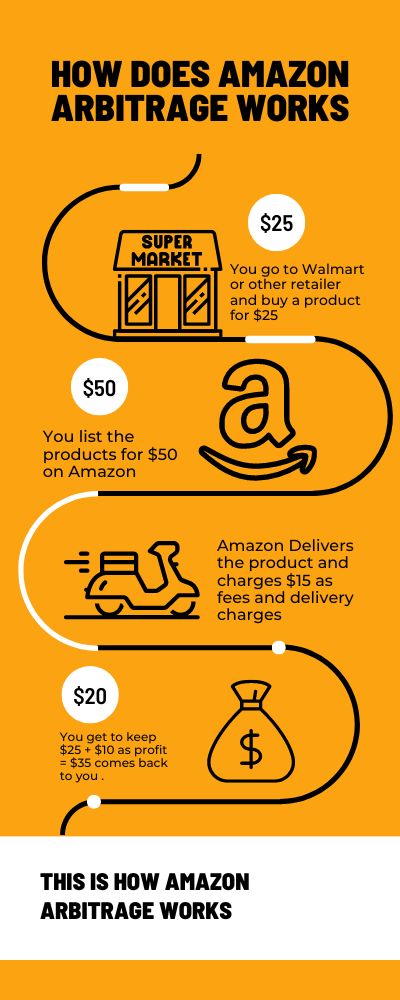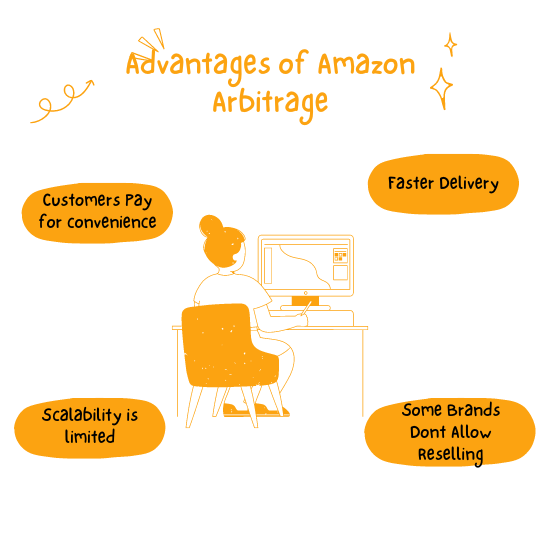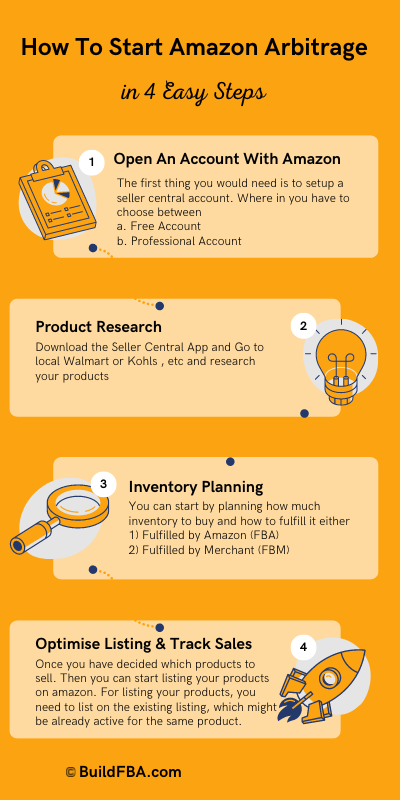Arbitrage on amazon is when you buy goods from retail stores or online stores at a lower price and sell on amazon at a higher price leading to a profit. When you buy from retail stores and sell on amazon, it's called retail arbitrage. Whereas when you buy products from online stores and sell them on amazon, it's called online arbitrage.

How Does Amazon Arbitrage Works?
Online arbitrage is very profitable during high seasons like Q4 since the demand for products is very high, whereas many products on amazon go out of stock due to high demand.
What is Amazon Arbitrage?
The process of buying products at lower prices from offline stores or online stores and selling them on amazon at higher prices is called arbitrage on amazon. You purchase products from a retail store and resell on amazon.
For. e.g., You buy a yoga mat for $6 at Walmart and sell them for $14 on amazon. Amazon keeps $4 as selling fees and FBA charges. And you pocket the difference of $4 as profit from arbitrage.
Difference Between Amazon Arbitrage Vs. Other Amazon Business models:
Though in arbitrage on amazon, there are two ways of doing arbitrage one is online arbitrage, and the other is retail arbitrage.
In retail arbitrage, you need to visit stores like Walmart, home depot, Costco, etc., and personally scan through each product to sell on amazon with the amazon app barcode scanner.
Whereas in online arbitrage, you visit the retailers' websites like Walmart, BestBuy, Staples, Target, etc.
1. Amazon Dropshipping Vs. Amazon Arbitrage
Dropshipping on Amazon is when you take orders online on amazon and then ask your supplier to ship the products directly to the customer. Dropshipping also is a business model wherein the seller doesn't hold any inventory.
In Arbitrage, you buy goods and hold them and also have the option to send goods to amazon fulfillment for faster delivery.
Whereas in Dropshipping, you don't hold any goods; you only act as an intermediary.
2. Wholesaling Vs. Amazon arbitrage
Wholesaling on amazon is one of the profitable business models wherein the seller holds a sizeable inventory by buying goods in bulk from manufacturers and then selling them on amazon.
Investment is generally higher, but it's also a highly scalable business model as compared to amazon's online arbitrage. Also, in arbitrage, the possibility of arbitrage disappearing is also high if other sellers also jump into the opportunity.
3. Private Label of products vs. Retail Arbitrage On Amazon
Private label needs you to get products directly manufactured from a factory in a local one or in another country. It's also little capital extensive since you must keep at least three months of capital upfront in inventory.
But the majority of sellers grow to a 7 to 8 figures business model; if you are looking to grow over a period of time then this model will work for you. Getting funds in the future after you have 6-8 months of experience selling on amazon won't be an issue. Apart from amazon lending, you also have other lending options to help you grow.
Whereas in retail arbitrage or online arbitrage sellers, you would need much lesser investment. And still, keep moderate margins. Some sellers make $10,000 a month doing online arbitrage or retail arbitrage on amazon.
Advantages of Arbitrage on amazon

Advantages of Amazon Arbitrage
- Customers Pay for Convenience: Customers prefer convenience over going to the store, and they are comfortable paying the extra price for it.
- Faster Delivery: Amazon fba makes retail arbitrage easier and faster; you can deliver your goods to customers much faster than other marketplaces. For that, you need to be fba seller on amazon.
- Most buyers are unaware of the prices of the products on the other websites, making online arbitrage a very profitable business model. Since most customers don't prefer to do research before buying regular products.
- Nomad: You can do online arbitrage even when you are away or in another country since it only needs an internet connection. But you will need help with warehousing to remove labels before shipping them to amazon fba.
- Tools: With the help of the tools like helium10 and JungleScout, we recommend it's quite easy to gauge competition as well sales of the products.
- Brand Availability: You can easily arbitrage with most established brands, where you don't have to spend on the advertising campaign or worry about sales.
- Profitability: Most sellers who do retail arbitrage or online arbitrage start with very low capital. In one of our recent surveys, it was seen that most start selling with investments as low as $800, or at least 44% of them.
Disadvantages of Amazon Arbitrage

- The margins on arbitrage can be very low as compared to private labeling, which typically enjoys anywhere from 25% to 35% depending on the product. Whereas online arbitrage has a margin of 5-7%, and retail arbitrage is a little higher at 6-8%.
- Amazon arbitrage can be very time-consuming since you have to research through various sites for online arbitrage. For retail, you have to scan through various products in Walmart or Home Depot to get the product that you can sell.
- The scalability of the amazon arbitrage model is limited, it can get you extra income, but it can't become your full-time business since its time consuming and opportunities keep changing in online arbitrage.
- Some brands won't be happy to see you selling them your products without approval.

How to get started with the Amazon Arbitrage model?
A. Start with Opening an Account:
Once you have decided to go with arbitrage on amazon as a business model, you need to setup up an amazon seller account, which is quite an easy task. You must put in some basic information and then choose between two accounts.
1. Free Account:
A free account is when you plan to sell less than 40 items per month. But you have to pay $0.99 per product sold.Apart from amazon fees which you pay anyways, irrespective of which account you choose.
2. Professional account
In a professional account, you pay $40 per month, irrespective of items sold. This is a good option if you plan to sell more than 40 products per month.
We believe it's always good to go for a professional account since you will easily end up selling more than 40 products per month with little effort.
Documents for Amazon Registration:
While registering with amazon, you will need the following information :
- Credit Card information
- A Govt Issued Identification like Passport or SSN (if US Resident)
- Bank Account Information for crediting of sales amount
- And Your Tax Information

B. Product Research
Which products to sell is an important decision since not all products have equal profitability or equal sales rank. Some will rank better but may have a higher number of sellers. Sales equity matters in such cases.
We recommend using Helium10 for your research needs. Not only its accurate but also it provides a wide variety of uses.
Step 1: Download the Amazon Seller App
You need to download the amazon seller central app, which has a scanner which can help you scan products in local stores and display critical information like
- Sales rank
- if permitted to sell
- Product pricing
- Shipping costs, etc
Step 2: Go to the Local Store:
You should visit the retail store after downloading the app,
Stores you can visit :
- Walmart
- Costco
- Target
- HomeDepot
- Dollar Store
- Kohls, etc
If you are planning to do offline arbitrage, we generally recommend visiting stores in states which don't have a sales tax so that you can get extra margins when you do arbitrage.
Also, if you are doing online arbitrage, I would recommend you to have a warehouse in non-sales tax states like Delaware, Oregon, etc.
You can check our list of pre-centers.
The best categories for amazon arbitrage are:
- Toys and Games,
- Baby Products,
- Office Products,
- Books, Health &
- Household Items.
Avoid electronic items.
C. Plan Your Inventory
Once you have decided on the products to purchase after research, you need to decide how you plan to ship your inventory.
Here you have two options:
1.Fulfillment by Merchant (FBM): FBM is a method wherein the delivery of goods from your warehouse to the customer's doorstep is taken care of by the seller. (in this case you) This method is used by sellers when they believe the item is low selling on amazon.
Or When the seller wishes to fulfill the products through his channels.
2. Fulfilled by Amazon (FBA): FBA is when you ship all your products to an amazon warehouse. And amazon takes care of everything from shipping the products to buyers in time bound manner to taking care of returns if needed.
To understand how Amazon FBA works, we have a detailed guide. Amazon FBA helps win more of buybox apart from faster shipping to customers.
Important!!
Don't forget to remove all third-party marketplace branding, like Walmart boxes, stickers, and invoices from the product before sending it amazon warehouse or to an amazon customer.
D. Optimise the Listing and Track Your Sales:
Once you have decided which products to sell. Then you can start listing your products on amazon. For listing your products, you need to list on the existing listing, which might be already active for the same product.
Considering that you will be doing arbitrage, its safe to assume that the product listing will already be active, and you don't need to create a new listing. But you can sell on existing listings of the same products on amazon.
Arbitrage sellers don't need to create new listings for the product most of the time.
Once you list your products to sell, you may need to optimize the listing. And also track your sales. Proper tracking of the sales helps in knowing if you are winning the buy box, which is critical for getting sales numbers.
Tip: Avoid playing the game of dropping the price to get a buy box. Instead, match the price and send your products to amazon fulfillment centers so that product reaches customers fast. And be fast in replying to customer queries.
How to choose the right product?
A critical factor in choosing the right product to sell on amazon by any method, retail arbitrage or online arbitrage, private label, or wholesale, is research, quality product, and listing optimization.
This all is possible only through an integrated app. One which we always recommended in many of our articles and videos.
Tips for identifying the right products for Amazon arbitrage sellers
1. Choosing the right app
There is a multitude of apps that help you research amazon. Some of them are 1. Amz Scout, 2. Viral Launch, 3. Jungle scout, 4. Helium10
Apart from the Amazon seller scanner app, which you will need when scanning products at Walmart and other places for profitability, we also recommend Helium10.
2. Check for Sales Volume
Once you have the right tools, you need to check whether there are enough sales for the product on amazon. Since, at times, the product may not have many sales, and you will end up with dead inventory.
3. Check for Restriction:
Once you choose the third-party app, you need to check whether the product you plan to sell via arbitrage has any Product Restrictions.
Also, keep your invoices handy if there is any dispute on the purchase of your products.
Pro Tip: But some brands don't like you selling their products on amazon; hence you need to follow some tips when selling on amazon arbitrage.
4. List Products in the proper category
It is imperative to list your product on amazon in the proper category; not doing so is not only a violation of amazon's selling policies but also would lead to lower sales rank. Since many times amazon sends the buyer to a specific category of the search when he searches for a product. Listing in the wrong category can affect sales badly.
5. Do not sell counterfeit products
This one is a complete no-go. Selling any counterfeit products on amazon will lead to permanent suspension of your selling privileges and suspension of your account. And not to mention bad customer reviews. Always get genuinity of your supplier checked before listing or dispatching the products to amazon fba or to buyers directly.
6. Check on the competition
Always keeping an eye on the competition is important to continue having good sales. Sometimes competitors might try to cut prices or introduce new products or run PPC. You don't want to lose on those sales.
7. Check Inventory levels
The worst thing to happen is to run out of inventory much faster than you predicted. Which is like losing important sales. Amazon will always try to alert you of the required number of units to be made available, but then sometimes it can exceed that during high season.
8. Account for expenses
Not accounting for expenses, if you don't know your profitability after all expenses, how can you grow? We always recommend to knowing all your expenses. Also, use the amazon fba calculator to know in advance what your expenses will be on that particular product.
9. Compare Prices
Are your prices in line with other competitors? or with the brand itself? This decision are important to match the price in order to achieve the buy box which is critical in boosting sales.
FAQs
Is Amazon Retail Arbitrage for You?
Amazon retail arbitrage or online arbitrage is a great one if you are someone with very limited capital and want to try hands-on selling on amazon to start with. Amazon Arbitrage isn't a long-term business model but its more of a hustling model. It works great during peak seasons but also during off-peak season, but the margins remain limited.
Is Retail Arbitrage Legal?
Yes, its legal. As per the SC ruling, any customer who has purchased the product legally has the complete right to resell that product.

Samrudha Salvi ‧ Author
With more than 5 years on selling on amazon, and helping 100s to get started on Amazon.
